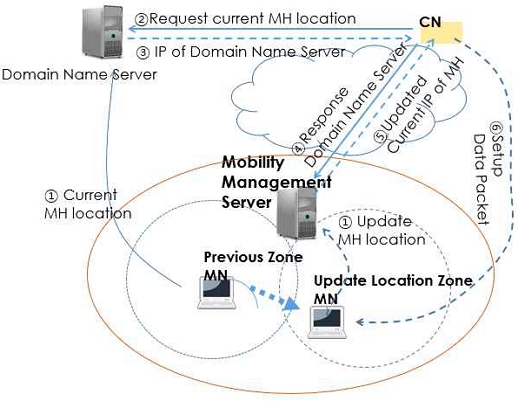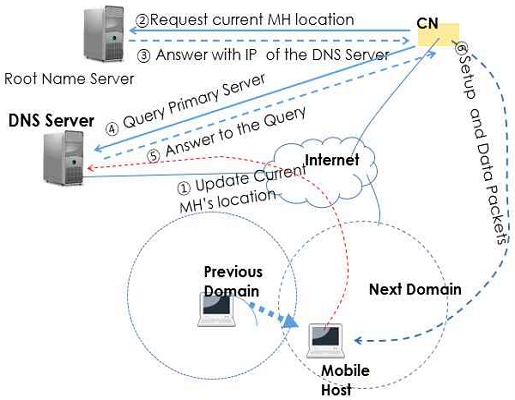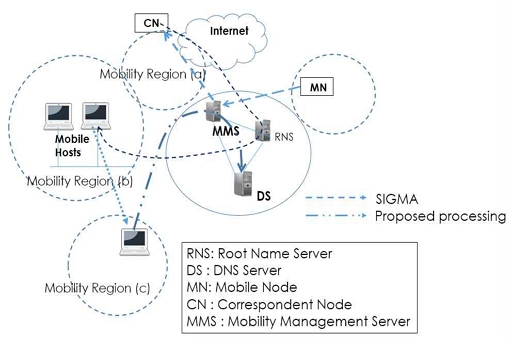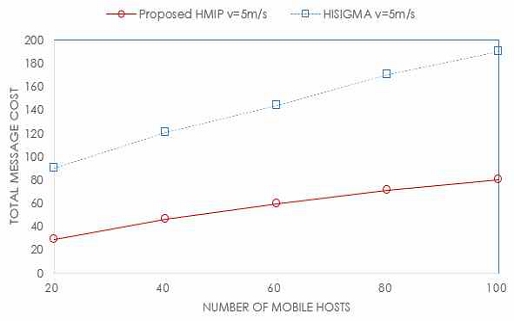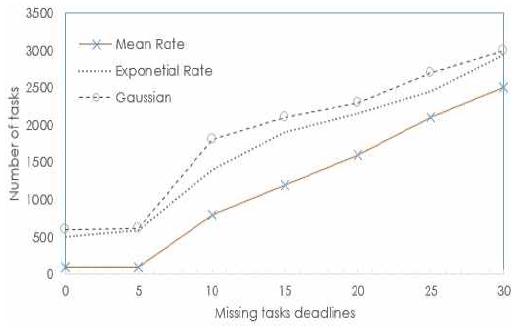
Improvement of the Location Update Delay and Packet Transmission of MH Movement on the Mobile IP Network Mobility Management Server
Abstract
IP movement support is based on terminal operation to recognize mobility while moving and maintain a continuous communication session. The main content of the paper is that the proposed HMIPv6 aims to reduce the delay time of location updates because of movement of MH. This paper in order to work out the problem that can cause excessive traffic and long delay, IP address locations are stored in geographically distributed mobility management servers, and when a request comes in, it is proposed to request information from the nearest server. By doing so, performance was improved by utilizing packet transmission through an optimized path. In the proposed method of this paper, if the average interaction CNs increases, the mobility location update cost extends. However, due to the hierarchical structure using the Mobility Management Server, the location update cost (δ) showed an average decrease of 12.8%. As a result, it is shown that the suggested method effectively lessen the cost compared to the existing method despite the high packet forwarding cost and not high mobility location update cost.
초록
IP 이동성 지원은 이동 중에서도 이동성을 인지하고 지속적인 통신 세션을 유지하기 위하여 터미널 동작을 기반으로 한다. 논문의 핵심 내용은 제안한 HMIPv6는 MH의 이동성으로 인하여 위치 업데이트의 지연을 감소하는 데 목적이 있다. 이를 위하여, 본 논문에서는 과도한 트래픽과 긴 지연을 초래할 수 있는 문제를 해결하기 위하여 IP주소 위치를 지리적으로 분산된 이동성 관리 서버에 저장하고, 요청이 들어왔을 때 가장 가까운 서버에 정보를 요청할 수 있도록 제안함으로써 최적화된 경로를 통한 패킷전송을 활용하여 성능을 향상하였다. 본 논문의 제안 방법에서 통신하는 CN의 평균 수가 증가하면 이동성 위치 업데이트 비용이 증가하는 값이 발생하지만, 제안 방법인 이동성 관리 서버를 이용한 계층적 구조로 인하여 위치 업데이트 비용 (δ)이 평균적으로 12.8% 감소함을 나타내었다. 결과적으로 이동성 위치 업데이트 비용이 많이 들지 않고 높은 패킷 전달 비용임에도 불구하고 제안 방법이 기존 방법보다 효과적으로 비용이 절감됨을 나타낸다.
Keywords:
mobility management, location update, packet transmission, HMIPv6, mobility protocolⅠ. Introduction
With fast development of mobile communication and wireless communication technology, the environment for mobile and wireless access to the Internet is increasing, and due to the Internet, smooth correspondence all over the world and various multimedia services are provided. Mobility support in IP networks is an important research topic in IP networks, such as IP networks started with services provided on switch circuits, such as voice services, and migration of existing IP supports such as IPv4 and IPv6, which recognize and sustain mobility of terminals in terminals. Mobile IP(MIP) [1] is considered to treat the movement of internet hosts of the network layer. There are disadvantages when using MIP in a mobile computing environment, and the biggest disadvantage is large delay, packet loss[2], and structural change is required.
A lot of research on network-based solutions is still in progress, and research on supporting mobility without depending on the configuration and function of a user terminal MN (Mobile Node) continues. Solutions have been developed that provide network-based mobility support for these requirements. In mobility management of communication networks, location management requires location update and call processing procedures to support user roaming. Location updates on the network provide user location information, and paging plays a role in supporting user calls[1][2]. Existing studies for optimizing signal processing cost include shift-based[3], length-based[4], and timer-based[5][6] processing, and multiple access according to the importance of timer parameters for user mobility. There is a network[7].
Mobile IP is based on the concept of Home Agent (HA) and Foreign Agent (FA), and routes packets from one region to another. At this time, the amount of real-time traffic continues to increase in the wireless network, resulting in high latency and packet loss, which incurs data transmission delay costs of Mobile IP.
HMIPv6 proposed in this paper reduces the delay and frequency of location updates in MH (Mobile Host) mobility. To this end, in this paper, in order to solve problems that can cause excessive traffic and long delays, we propose to store IP address locations in geographically distributed mobility management servers and to request information from the nearest server when a request comes in. By doing so, performance was improved by utilizing packet transmission through an optimized path. In the proposed method of this paper, The mobility location update cost increases as the average number of communication CNs increases, but the location update cost(δ) decreases due to the hierarchical structure of the mobility management server. In the proposed content, it is shown that the cost is reduced compared to the existing method even when considering the high packet transmission cost and low mobility location update cost.
The main contents of this paper are as follows. Chapter 2 presents the basic structure of the SIGMA Location Management and Mobility Management Server. Chapter 3 presents the mobility model and traffic model-based network structure proposed in this paper. Chapter 4 evaluates HiSIGMA's hierarchical mobility management analysis model, and Chapter 5 conclusions are presented, and it mentions future research tasks of this thesis.
Ⅱ. Related Work
2.1 SIGMA location management basic structure
Transport hierarchical mobility structure for SIGMA is shown in Figure 1[3]. In Figure 1, MH uses the current default IP address for location manager modifications. The CN queries the root name server using the MH's domain name, and the domain name server processes the CN with the IP address of the remediation name server used by the MH. The name server uses the current default IP address for MH.
For the CN mobile continuity connection, the new primary IP address of the MH is assigned as an initial value. Such high user mobility processing has a disadvantage in frequent mobility handover processing[6]-[8].
If the processing time of MH and location management increases, MH may not be able to access to CN, and when MH changes location, processing time of mobility management increases due to location update execution, resulting in waste of network bandwidth.
2.2 Mobility management server architecture
Figure 2 shows the mobility management server structure for mobility management[11]. The MN updates the mobility management server only when the moved location changes. When the domain server requests MH location information, the registered mobility management server IP address responds.
This processing reduces the location update delay and signal cost, and improves the accuracy of mobile location management. The MN modifies the location of the current MH's domain name server and mobility management server. An MH location query is generated, and the IP address of the mobility management server registered in the initial area server responds.
Ⅲ. The Proposed Scheme
In this paper, we improve the accuracy of mobile location management by improving location update delay and packet transmission. As the MH moves from the Mobility Management Server, the IP address is continuously modified, and there may be more than one IP address for the MH in the SIGMA structure [5][6]. MH has the flexibility to be used at specific times due to application characteristics (data) and cost constraints, and to optimize transport layer mobility solutions for IP support at SIGMA, we propose a mobility management server. The mobility management server takes precedence when multiple IP addresses are available, and the IP address needs an explicit location value. When the MH sends the reconfigured signaling message to the CN, the MH shall also send the reconfigured signaling message to the mobility management server. These messages are enclosed in[7].
The signal message indicates the architecture of the mobility management server with the current location status of the MH, and the structure of the mobility management server is shown in Figure 3, and the processing procedure is as follows.
The main content of the paper compares the performance of HMIPv6 and mobile protocols in the hierarchical transport layer. TThe proposed HMIPv6 reduces the delay and frequency of location updates with the mobility of MH. The HA of HMIPv6 and the operation of peer nodes are handled the same as MIPv6. A new network element, the Mobility Management Point, is used to add a hierarchical structure to Mobility Management and acts as a Mobility Management Local Home Agent.
- When the MH roams between subnets within the Mobility Management Point area, it sends location updates to the local Mobility Management Point instead of the more distant and heavily loaded HA.
- HA is modified when MH is out of range.
The HMIPv6 processing process is as follows. An MH entering the mobility management point domain receives local mobility management pointer or router information including one or more pieces of information. The MH changes the HA from the address used by the Mobility Management Point (MMP) to the current location, the Regional Care of Address(CoA). The Mobility Management Point receives all packets transmitted from the MH, encapsulates all packets and transmits them to the MH's current address. If the MH changes within the Mobility Management Point domain, it uses a new local CoA for the AR.
The mobility according to the change of the local CoA of the MH makes the HA transparent and there is no need to update the H as it remains unchanged as long as the MH is maintained within the area of the mobility management point.
The notation used to improve the analysis model of the existing HiSIGMA and HMIPv6 is as follows. For consistency, the similar notation used in [9] for the HMIPv6 proposed structure is as follows.
In HMIPv6, the MH does not need to register with the HA until the MH moves out of the mobility management pointer area. Instead, only the mobility management point is registered. Therefore, all sub nets intersected within the Mobility Management Pointer serve to process registrations into the Mobility Management Pointer.
Such cost processing includes the transmission processing cost of the location update message(MMPprocessingcost) and the cost of processing updates to the MMP(LocUcost) is included. Therefore, the expression is
| (1) |
Notation applied to the proposed HMIPv6 message cost handling
| (2) |

Cost variable parameters for registration requests and response messages to HA for message processing costs
For the intersection area of the MMP, MH represents the transmission cost and processing cost for the HA, and the message processing cost registers both the registration request and response message to the HA using the MMP.
| (3) |
Same as the established HiSIGMA, the number of CNs in MH has no effect on location updates. Therefore, the average location update cost per second for the entire system is calculated by multiplying the location update cost for each MH and dividing it by the average subnet uptime.
For the packet forwarding cost based on the analysis in [9], in this paper, only the costs related to HA and MMP tunneling and location update database search costs are targeted. The processing cost of each packet sent from CN to MH is as follows.
-HA encapsulation and localization
-Encapsulation, non-encapsulation and localization in MMP
Considering the cost per location database lookup in HA and MMP, per encapsulation or non-encapsulation in HA or MMP, the linear constant for location database lookup is:
It is expressed by the following equation (4).
| (4) |
Therefore, the cost of forwarding packets from CN to MH can be calculated, as the sum of the costs processed by tunneling and database lookup in the system as in Equation(4). These costs are as follows.
| (5) |
Ⅳ. Performance Evaluation
The purpose of this paper is to perform an analysis based on the results obtained from the user traffic mobility model[6] and the paper[9], and to compare the performance of HMIPv6 and the mobility protocol of the hierarchical transport layer. The proposed HMIPv6 reduces the delay and frequency of location updates due to the mobility of MH.
For performance evaluation, we present the results of input parameters affecting the mobility location update cost of the existing method [11] and the proposed method. When location update time = 60 seconds and MH = 100, the relationship between the location update cost and the average number of CNs communicating with the MH is shown in Figure 4. As the average number of communicating CNs increases, the mobility location update cost increases (Equations (2), (3) and (4)). However, Fig. As shown in 4 and 5, the proposed method reduces the location update cost by about 12.8% on average by using a hierarchical structure using a mobility management server.
As a result, it can be seen that the mobility location update delay time of the proposed method is reduced in cost compared to the existing method. It can be seen that the cost is significantly reduced compared to the conventional method.
As shown in Equation 5, if the location update cost per second increases, the total message processing cost of HiSIGMA and the proposed HMIPv6 decreases.
The method proposed in this paper provides a minimum message size compared to the existing methods[9][10], which plays a role in improving packet transmission and reducing message processing cost. As shown in Figure 5 below, since the time spent in each region changes, if the number of MH increases, message processing cost increases in existing HiSIGMA and proposed HMIPv6.
For this analysis, Figure 6 shows the dynamic structure of IP datacast for registered location information in MN with Gaussian and exponential distribution.
Figure 6 Gaussian distribution is used for optimal scheduling and task allocation, and processor task scheduling analysis by different speed distributions confirms that the speed of processors is optimally scheduled in Gaussian distribution.
These results show that the cost of having a timeout period is reduced by using the proposed algorithm rather than the existing method. Recently, this structure can be very dynamic in the number of mobile clients in a cell, so cost reduction and location update in a real-time processing system It can reduce the search total latency.
Ⅴ. Conclusions
In this paper, we compared the performance of the proposed hierarchical transmission method and HMIPv6 and mobility protocols. The proposed HMIPv6 reduces the delay and frequency of location updates with the mobility of MH. For comparison of message processing cost between existing HiSIGMA and HMIPv6, shows improved results through performance evaluation, and introduces MMP to reduce the total message processing cost of the proposed HMIPv6 compared to HiSIGMA. In addition, the result of this paper is confirmed that the speed of the processors is optimally processed in the Gaussian distribution, and the mobility location update delay of HMIPv6 is improved. As the number of CNs increases, the mobility location update cost increases, but the location update cost is reduced by about 12.8% on average by using a hierarchical structure in the mobility management server. Since the number of mobile clients in a cell can change dynamically, it is expected that this method can be utilized to reduce the cost and total latency of retrieving location updates from real-time processing systems.
References
-
C. E. Perkins, "Mobile Networking Through Mobile IP", IEEE Internet Computing, Vol. 2, No. 1, pp. 58–69, Jan. 1998.
[https://doi.org/10.1109/4236.656077]

- K. E. Malki, "Low latency handoffs in MobileIPv4", draft-ietf-mobileip–lowlatency–handoffsv4-07.txt, Jun. 2007.
-
S. Fu, L. Ma, M. Atiquzzaman, and Y.-J. Lee, "Architecture and performance of SIGMA: a seamless mobility architecture for data networks", Institute of Electrical and Electronics Engineers, Seoul, Korea, May 2005.
[https://doi.org/10.1109/ICC.2005.1495024]

- D. A. Maltz and P. Bhagwat, "MSOCKS: An architecture for transport layer mobility", INFOCOM, San Francisco, USA, pp. 1037-1045, Mar. 1998.
-
H. Soliman, et al., "Hierarchical Mobile IPv6 mobility management(HMIPv6)", IETF DRAFT, draft-ietf-mipshop-hmipv6–04.txt, Aug. 2005.
[https://doi.org/10.17487/rfc4140]

-
A. C. Snoeren and H. Balakrishnan, "An End-to-End Approach to Host Mobility", ACM MobiCom, Boston, MA, pp. 155–166, Aug. 2000.
[https://doi.org/10.1145/345910.345938]

-
Y. W. Chung, D. K. Sung, and A. H. Aghvami, "Steady state analysis of P-MIP mobility management", IEEE Communication Letters, Vol. 7, No. 6, pp. 278-280, Jun. 2003.
[https://doi.org/10.1109/LCOMM.2003.813797]

-
M. E. Crovella and A. Bestavros, "Self-similarity in World Wide Web traffic: evidence and possible causes", IEEE/ACM Transactions on Networking, Vol. 5, No. 6, pp. 835–846, Dec. 1997.
[https://doi.org/10.1109/90.650143]

-
J. Xie and R. Akyildiz, "An optimal location management scheme for minimizing signaling cost in Mobile IP", 2002 IEEE International Conference on Communications. Conference Proceedings. ICC 2002, New York, USA, pp. 3313–3317, Apr. 2002.
[https://doi.org/10.1109/ICC.2002.997445]

-
S. Fu and M. Atiquzzaman, "WLC35-2: Hierarchical Location Management for Transport Layer Mobility", IEEE Globecom 2006, San Francisco, CA, USA, Nov. 2006.
[https://doi.org/10.1109/GLOCOM.2006.818]

-
C. H. Park and S. Y. Oh, "Hierarchical Location Mobility Management using Mobility Management Points in IP networks", Journal of Korea Multimedia Society, Vol. 25, No. 8, pp. 1069-1074, Aug. 2022.
[https://doi.org/10.9717/kmms.2022.25.8.1069]


1999 : Ph.D. in Computer Engineering from Kwangwoon University
1999 ~ present : professor in the Department of Smart IT at Doowon Institute of Technology
Research interests : data analysis (network, image recognition processing) and learning, intelligent IoT, HCI, multimedia data communication, and computer vision

1985 ~ 1989 : B.S. degrees in Computer engineering from Gachon University
1989 ~ 1999 : M.S. and Ph.D. degrees in Computer engineering from KwangWoon University
1992 ~ present : Professor in the Department of Computer Engineering, Gachon University
Research interests : voice recognition, noise detect, and voice feature extraction, multimedia data communication

